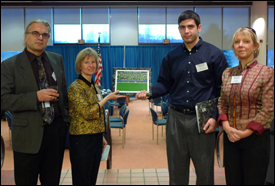 |

|
 |
Stephan Koev with three members of the steering committee for the MEMS Alliance. Left to right: Applied Physics Lab Research Scientist Robert Osiander, Associate Professor Elisabeth Smela (ME), Stephan Koev, and APL's Ann Garrison Darrin, a co-founder of the MEMS Alliance. |
|
Stephan Koev, a Ph.D. student of Herbert Rabin Distinguished Associate Professor Reza Ghodssi (ECE/ISR) won the Best Student Poster Award at the 2008 MEMS Alliance Symposium. The event was held at the Johns Hopkins Applied Physics Lab (APL) on Monday, Nov. 24.
The poster explains research on optical microantilever sensors for liquid samples being conducted in the Clark School of Engineering's MEMS Sensors and Actuators Laboratory and the Center for Biosystems Research at the University of Maryland Biotechnology Institute. The researchers are Koev, Ghodssi, Robert E. Fischell Distinguished Professor and Fischell Department of Bioengineering Chair William Bentley and his student Rohan Fernandes.
Microcantilever sensors are versatile tools for chemical and biological detection. However, they have one major drawback: the measurement of beam displacement typically involves elaborate off-chip setups with free-space optics. The research presents for the first time a cantilever with integrated optical readout capable of interrogating liquid samples.
The measurement of beam displacements is performed through on-chip waveguides, and the off-chip setup is greatly simplified. This method results in a 0.4% change in output optical power per nanometer of cantilever displacement. The device operation was demonstrated by detecting 5 mM homocysteine, which caused a surface stress of 0.17 N/m due to binding to the cantilever surface. The presented cantilever can be readily adapted to other sensing applications by selecting an appropriate coating layer.
November 26, 2008
|

